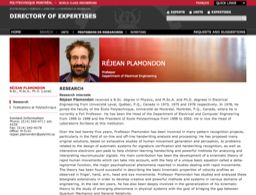Séminaire Donnees et APprentissage Artificiel
 Neuromuscular Modelling and Analysis of Handwriting: from Automatic Generation to Biomedical and Neurocognitive applications.
Neuromuscular Modelling and Analysis of Handwriting: from Automatic Generation to Biomedical and Neurocognitive applications.
15/05/2013Intervenant(s) : Réjean Plamondon (Laboratoire Scribens, École Polytechnique de Montréal)
Many models have been proposed over the years to study human movements in general and handwriting in particular: models relying on neural networks, dynamics models, psychophysical models, kinematic models and models exploiting minimization principles. Among the models that can be used to provide analytical representations of a pen stroke, the Kinematic Theory of rapid human movements and its family of lognormal models has often served as a guide in the design of pattern recognition systems relying on the exploitation of the fine neuromotricity, like on-line handwriting segmentation, signature verification as well as in the design of intelligent systems involving in a way or another, the global processing of human movements. Among other things, this lecture aims at elaborating a theoretical background for many handwriting applications as well as providing some basic knowledge that could be integrated or taking care of in the development of new automatic pattern recognition systems to be exploited in biomedical engineering and cognitive neurosciences.
More specifically, we will overview the basic neuromotor properties of single strokes and will explain how they can be superimposed vectorially to generate complex pen tip trajectories. Doing so, we will report on various projects conducted by our team and our collaborators. First, we will present a brief comparative survey of the different lognormal models. Then, from a practical perspective, we will describe some parameter extraction algorithms suitable for the reverse engineering of individual strokes as well as of complex handwriting signals. We will show how the resulting representation could be employed to characterize signers and writers and how the corresponding feature sets could be exploited to study the effects of various factors, like aging and health problems, on handwriting variability. We will also describe some methodologies to generate automatically huge on-line handwriting databases for either writer dependent or writer independent applications as well as for the production of synthetic signature databases. From a theoretical perspective, we will explain how, using an original psychophysical set up, we have been able to validate the basic hypothesis of the Kinematic Theory and to test its most distinctive predictions. We will complete this survey by explaining how the Kinematic Theory could be utilized to improve some signal processing techniques, opening a window on novel potential applications for on-line handwriting processing, particularly to provide some benchmarks to analyze children handwriting learning, to study aging effects on neuromotor control as well as developing diagnostic systems for neuromuscular disorders. To illustrate this latter point, we will report typical results obtained so far for the assessment of brain stroke most important modifiable risk factors (diabetes, hypertension, hypercholesterolemia, obesity, cardiac problems, cigarette smoking).
Plus d'informations ici …
Adrien.Revault-d'Allonnes (at) nulllip6.fr

